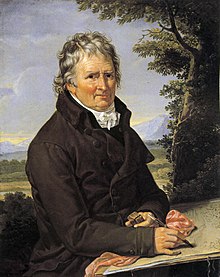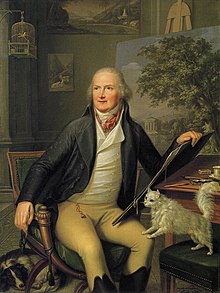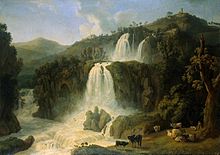Jakob Philipp Hackert

Jakob Philipp Hackert , actually Philipp Hackert (* 15. September 1737 in Prenzlau ; † 28. April 1807 in San Piero di Careggio today Careggi , part of Florence ) was a German landscape painter of Classicism .
Life
Jakob Philipp Hackert began his artistic training in the workshop of his father Philipp Hackert († 1786) and his uncle, a Berlin decorative painter. He attended the Academy of Fine Arts Berlin from 1758 and first drew attention to himself in 1761 with two vedute . The Swedish government councilor Adolf Friedrich von Olthof invited him (together with Georg David Matthieu ) to Stralsund , Rügen and Stockholm , where Hackert executed wall paintings in his town house (today Ossenreyerstraße 1 ) and on his country estate, the manor house Boldevitz .
Hackert spent the years 1765 to 1768 together with Balthasar Anton Dunker in Paris . There he was shaped by the landscape and marine painter Claude Joseph Vernet (1714–1789) and the copper engraver Johann Georg Wille (1715–1808), who accompanied and supported him during his time in Paris.
After traveling to Normandy and Picardy , he went to Italy with his brother in 1768 , where he met the art patrons Johann Friedrich Reiffenstein and William Hamilton in Rome and Naples . Hackert subsequently traveled all over Italy and soon made a name for himself as an important landscape painter. He received numerous commissions from the European nobility and in 1786 became court painter to King Ferdinand IV of Naples . In the same year Hackert met Johann Wolfgang von Goethe there , who gained great appreciation for the painter and took drawing lessons from him.
As a result of the Lazzaroni -Aufstandes in Naples fled Hackert and came over Livorno and Pisa to Florence , where he settled 1,803th He bought a small estate in the neighboring "San Piero di Carregio" ( Careggi ) and had his studio there.
After Hackert's death, Goethe wrote a biographical sketch of the landscape painter in 1811.
Hackert was an extremely successful artist in his day. The fact that his brother Georg made engravings from individual paintings also contributed to this. He was the most respected landscape painter of early classicism. In contrast to Italian contemporaries, such as Francesco Piranesi , who composed heroic landscapes, Hackert's vedute was topographically accurate and true to detail.
Catalog raisonnés
- Norbert Miller ; Claudia Nordhoff: Instructive closeness to Goethe and Hackert . Inventory of the paintings and graphics by Jakob Philipp Hackert in the collections of the Goethe National Museum Weimar. Correspondence between Goethe and Hackert. Art theoretical notes from Hackert's estate, Munich 1997.
- Claudia Nordhoff; Hans Reimer: Jakob Philipp Hackert (1737–1807). List of his works , Berlin 1994.
Works (excerpt)
- Wallpaper room in Stralsund, Ossenreyerstraße 1
- Sinking of the Turkish fleet in the battle of Tschesme (St. Petersburg, Ermitage), 1771, oil on canvas, 162 × 220 cm
- Arcadian River Landscape , ( Goethe Museum ), Frankfurt am Main, 1775, oil on canvas.
- View of St. Peter in Rome (Frankfurt am Main, Städel ), 1777, oil on canvas, 72 × 90 cm.
- Italian Landscape (Boldevitz on Rügen, Germany), 1778, oil on canvas, 65 × 88.5 cm.
- Landscape with temple ruins in Sicily (St. Petersburg, Hermitage), 1778, oil on canvas, 123 × 170 cm.
- Coastal landscape (Hamburger Kunsthalle), around 1780, oil on canvas, 33.5 × 52.5 cm
- Ferdinando IV a caccia di folaghe sul Lago Fusaro (Napoli, Museo di Capodimonte), 1783, oil on canvas, 141 × 219 cm
- Villa des Maecenas with the waterfalls in Tivoli (St. Petersburg, Ermitage), 1783, oil on canvas, 121 × 169 cm
- The great waterfalls in Tivoli (St. Petersburg, Ermitage), 1783, oil on canvas, 120 × 170 cm
- Autumn - grape harvest near Sorrento (Cologne, Wallraf-Richartz-Museum), around 1784, oil on canvas, 97 × 66 cm
- View of the Bay of Baia (St. Petersburg, Hermitage), 1785, oil on canvas, 144.5 × 228.7 cm
- The great waterfall in Tivoli (Vienna, Austrian Gallery), 1790, oil on canvas, 120 × 196 cm
- Lago d'Averno (Munich, Neue Pinakothek, inv.no.10162), 1794, tempera on paper laid down on cardboard, 57.6 × 83.6 cm
- Ponte a Mare a Pisa (Greifswald, Pommersches Landesmuseum), 1799, oil on canvas, 64.3 × 96.3 cm
- The monk's sermon (private property, Berlin)
literature
- Johann Wolfgang von Goethe: Philipp Hackert. Biographical sketch. Mostly based on his own essays, designed by Goethe in 1811. In: Goethe, Johann Wolfgang von: Art-theoretical writings and translations. Schriften zur Bildenden Kunst, Vol. 19, Berlin 1973, pp. 523–721.
- Joseph Eduard Wessely : Hackert, Philipp . In: Allgemeine Deutsche Biographie (ADB). Volume 10, Duncker & Humblot, Leipzig 1879, p. 295 f.
- Wolfgang Freiherr von Löhneysen: Hackert, Jakob Philipp. In: New German Biography (NDB). Volume 7, Duncker & Humblot, Berlin 1966, ISBN 3-428-00188-5 , p. 410 ( digitized version ).
- Wolfgang Krönig; Reinhard Wegner: Jakob Philipp Hackert - the landscape painter of the Goethe era. Cologne 1994.
- Gerd-Helge Vogel : The dream of earthly paradise in the landscape art of Jacob Philipp Hackert. In: Gerd-Helge Vogel, Rolf H. Seiler (eds.): The dream of earthly paradise. The landscape art of Jakob Philipp Hackert. Verlag Atelier im Bauernhaus & Galerie-Verlag, Fischerhude 1996 (ROMANTIK-edition Vol. 3).
- Thomas Weidner: Jakob Philipp Hackert. Landscape painter in the 18th century. Vol. 1. Berlin 1998.
- Jakob Philipp Hackert. Europe's landscape painter of Goethe's time . Ed .: Klassik Stiftung Weimar; Hamburger Kunsthalle. Text by Hubertus Gaßner , Hermann Mildenberger, Claudia Nordhoff, Peter Prange, Simon Reynolds, Hein-Th. Schulze-Altcappenberg, Andreas Stolzenburg, Reinhard Wegner u. a. (Hatje Cranz), Ostfildern 2008.
- Sabine Bock ; Thomas Helms: Boldevitz. History and architecture of a Rügen estate. Thomas Helms Verlag , Schwerin 2007. ISBN 978-3-935749-92-3
- Jakob Philipp Hackert. Letters (1761-1806). Edited and commented by Claudia Nordhoff. Hainholz Verlag , 2012. ISBN 978-3-86988-222-2
Web links
- Literature by and about Jakob Philipp Hackert in the catalog of the German National Library
- Literature about Jakob Philipp Hackert in the state bibliography MV
- Works by Jakob Philipp Hackert at Zeno.org .
- The Hackert paintings on Gut Boldevitz at Monuments Online
- Philipp Hackert in the Goethezeitportal of the LMU Munich
Individual evidence
- ^ First name form of the New German Biography
- ↑ The place of death follows the information in the Neue Deutsche Biographie (NDB), vol. 7 (1966), p. 410. Deviating from this, Jürgen Theil [Hrsg.] In Prenzlauer Stadtlexikon und Geschichte in Daten (Prenzlau, 2005, page 70): “ in Florence ”. This place is also mentioned on an information board at the Hackert monument in Prenzlau. Statements that this information actually corrects the NDB representations have not (so far) been known.
- ↑ Cf. Michael Lissok: Hackert or not Hackert? New insights into the authorship of the wallpaper paintings in the house Ossenreyerstraße 1 in Stralsund. In: Baltic Studies. New series, Vol. 102, 2016, Kiel 2017, pp. 149–167.
| personal data | |
|---|---|
| SURNAME | Hackert, Jakob Philipp |
| ALTERNATIVE NAMES | Hackert, Philipp; Hackert, Jacob Philipp; Hackert, Giacomo Filippo |
| BRIEF DESCRIPTION | German landscape painter of classicism |
| DATE OF BIRTH | September 15, 1737 |
| PLACE OF BIRTH | Prenzlau |
| DATE OF DEATH | April 28, 1807 |
| Place of death | San Piero di Careggi (country estate near Florence) |




